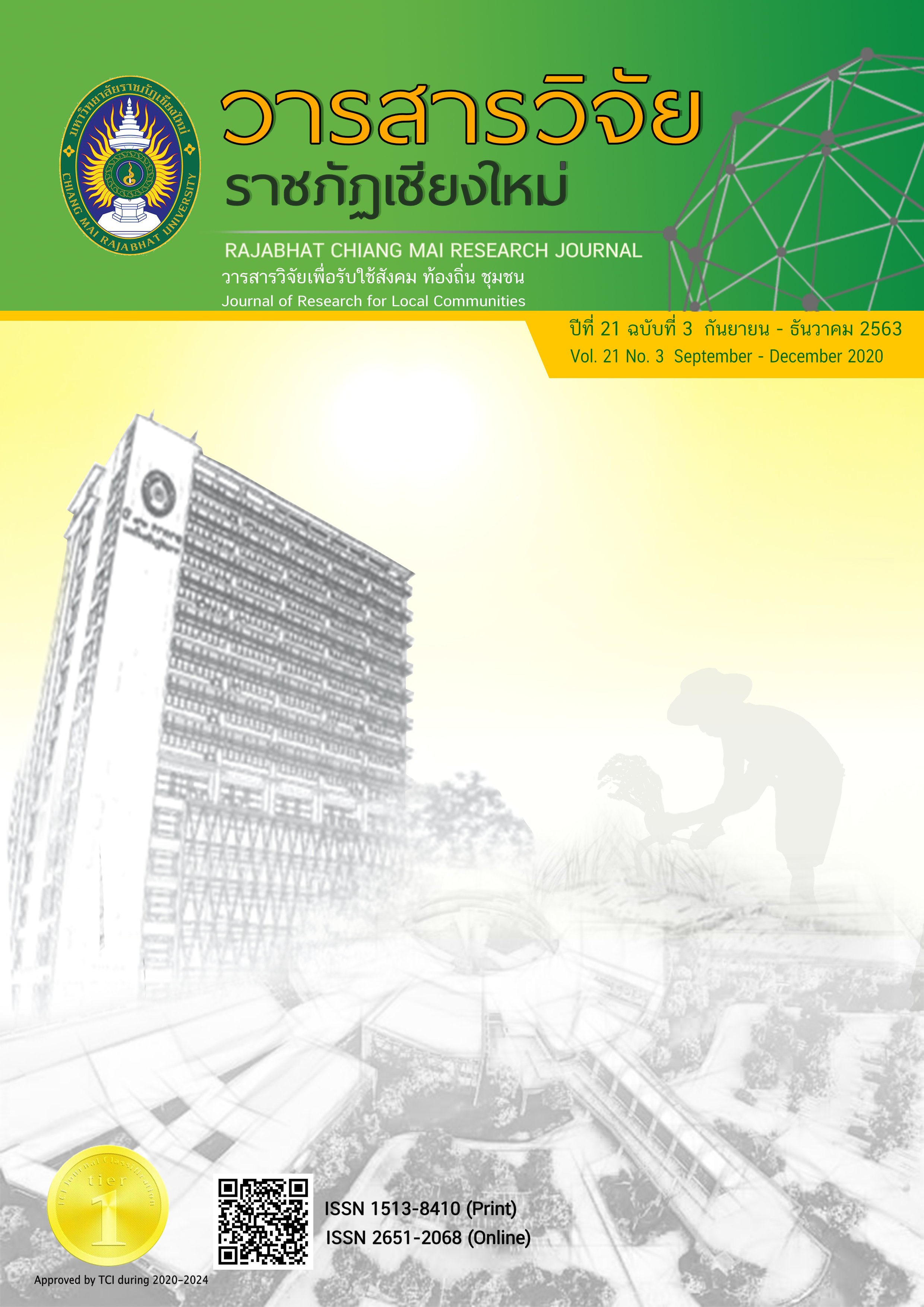การมีส่วนร่วมในการจัดการทรัพยากรน้ำของเกษตรกรชาวนาในพื้นที่ปลูกข้าวหลักของจังหวัดเชียงใหม่
DOI:
https://doi.org/10.14456/rcmrj.2020.240047คำสำคัญ:
การมีส่วนร่วมของเกษตรกรชาวนา, การจัดการทรัพยากรน้ำ, พื้นที่ปลูกข้าวหลักบทคัดย่อ
การวิจัยนี้มีวัตถุประสงค์เพื่อศึกษาประชากรศาสตร์ การใช้น้ำเพื่อปลูกข้าวของเกษตรกรชาวนา และการมีส่วนร่วมในการจัดการทรัพยากรน้ำของเกษตรกรชาวนาในพื้นที่ปลูกข้าวหลักของจังหวัดเชียงใหม่ ซึ่งเป็นงานวิจัยเชิงคุณภาพ โดยกำหนดกลุ่มตัวอย่างจำนวน 392 คน ใช้เครื่องมือในการศึกษา คือ แบบสอบถามและวิเคราะห์ข้อมูลโดยใช้สถิติพรรณนา และใช้ค่าเฉลี่ยถ่วงน้ำหนักเพื่อศึกษาระดับการมีส่วนร่วมในการจัดการทรัพยากรน้ำของเกษตรกรชาวนาโดยใช้แบบมาตราส่วนประมาณค่า กำหนดค่าน้ำหนัก 5 ระดับตามวิธีการของลิเคิร์ท และวิเคราะห์ข้อมูลจากเนื้อหาเชิงลึก
ในการศึกษาด้านประชากรศาสตร์ของเกษตรกรชาวนาพบว่าส่วนใหญ่เป็นเพศชายมีประสบการณ์ในการจัดการทรัพยากรน้ำในการปลูกข้าวอยู่ในช่วง 21-30 ปี และมีรายได้จากการปลูกข้าวมากกว่า 50,000บาทต่อปี มีพื้นที่ทำนาน้อยกว่า 4 ไร่อยู่ในเขตพื้นที่ชลประทานที่มีการจัดสรรน้ำตามรอบเวรเข้าสู่พื้นที่นำนาอย่างทั่วถึงผ่านฝายทดน้ำเข้าสู่หนองและบึงในพื้นที่ของเกษตรกรเพื่อกักเก็บไว้ในในการทำนา ซึ่งจะมีการทำนาจำนวน 2 ครั้งต่อปี
เมื่อศึกษาการมีส่วนร่วมของเกษตรกรในแต่ละด้าน พบว่า ด้านการมีส่วนร่วมคิดเกษตรกรที่มีส่วนร่วมในระดับมากที่สุดคืออำเภอแม่อาย โดยมีระดับการมีส่วนร่วมให้ความคิดหรือข้อมูลข่าวสารผ่านช่องทางต่าง ๆ อยู่ในระดับมากที่สุด ด้านการมีส่วนร่วมจัดทำแผนเกษตรกรที่มีส่วนร่วมในระดับมากคือพื้นที่อำเภอฝาง โดยมีการวางแผนการปลูกพืชและกิจกรรมที่ต้องใช้น้ำในชุมชนในระดับมาก ด้านการมีส่วนร่วมปฏิบัติเกษตรกรที่มีส่วนร่วมในระดับมากคือพื้นที่อำเภอฝาง โดยมีส่วนร่วมมากที่สุดในการเป็นคณะกรรมการหรือคณะทำงาน และร่วมทำงานเกี่ยวกับการจัดการน้ำในพื้นที่ ด้านการมีส่วนร่วมติดตามผลและประเมินผลเกษตรกรที่มีส่วนร่วมในระดับมากที่สุดได้แก่พื้นที่อำเภอแม่อาย โดยมีส่วนร่วมในการสอดส่องดูแลไม่ให้เกิดการลักลอบรับน้ำก่อนกำหนด หรือปิดกั้นทางน้ำในระดับมากที่สุด ด้านการมีส่วนร่วมรับประโยชน์เกษตรกรที่มีส่วนร่วมในระดับมากได้แก่พื้นที่อำเภอฝางโดยมีส่วนร่วมระดับมากที่สุดในการมีความรู้สึกร่วมเป็นเจ้าของทรัพยากรน้ำในพื้นที่
โดยการมีส่วนร่วมที่ส่งผลให้การจัดการทรัพยากรน้ำเพื่อการปลูกข้าวให้สำเร็จได้นั้นเกษตรกรต้องมีส่วนร่วมคิดโดยคำนึงถึงทรัพยากรน้ำต้นทุน การสำรวจพื้นที่ จำนวนครั้งในการปลูกข้าว และมีส่วนร่วมวางแผนการใช้น้ำให้สอดคล้องและมีส่วนร่วมปฏิบัติในการจัดสรรน้ำตามแผน การดูแลรักษา ภายหลังการจัดสรรน้ำเสร็จสิ้นจะต้องมีส่วนร่วมในการประเมินการใช้น้ำและปัญหาเพื่อนำไปสู่การมีส่วนร่วมในการคิดในขั้นตอนแรก อันจะส่งผลให้เกษตรกรมีส่วนร่วมในการได้รับผลประโยชน์ในการได้รับน้ำเพื่อใช้ในการปลูกข้าวอย่างมีประสิทธิภาพ
Downloads
เอกสารอ้างอิง
Cohen, J.M., & Uphoff, N.T. (1981). Rural Development Participation: Concept and Measure for Project Design Implementation and evaluation. Rural Development Committee Center for International Studies. New York: Cornell University Press.
Duangchit, P. (2015). Irrigation system management by integrated Buddhist principles: A case study of Mae- Taeng operation and maintenance project, Chiang Mai Province. Rajabhat Chiang Mai Research Journal, 16(2), 61-74. (In Thai)
Jongpiambowonchai, I. (2017). A model of integrated Buddhist participation in irrigation management of water-users organization in the Lower Northern Basin. Rajabhat Chiang Mai Research Journal, 18(1), 43-58. (In Thai)
Khao Sa-ard, M. (2001). Water sector profile and strategy for Thailand. A research project in water resource management. Bangkok: Thailand Research Fund. (In Thai)
Khuwaranyoo, T.N. (2011). Holistically integrative research. Bangkok: Chulalonkorn University Press. (In Thai)
Narata, P. (2014). The Member’s attitude to the performance of the Mae Taeng irrigation water user association committee, Chiang Mai. Rajabhat Chiang Mai Research Journal, 15(2), 61-69. (In Thai)
Naruthum, C. (2008). Development of participatory agriculture. Bangkok: Thammasat University. (In Thai)
Rinsri, K. (2014). Buddhism integrated water resources management: A case study of the Ping River Conservation Organization, Chiang Mai Province. Rajabhat Chiang Mai Research Journal, 15(2), 47-59. (In Thai)
Royal Irrigation Department, Public Participation Promotion Division. (2011). Participatory Irrigation Management (PIM), the Operation and Maintenance. (2nd ed.). Bangkok: Royal Irrigation Department. (In Thai)
Royal Irrigation Department, Public Participation Promotion Division. (2011). Water management and administration organization of irrigation water users for farmers. (2ndedition). Bangkok: Royal Irrigation Management. (In Thai)
Sincharu, T. (2010). Statistical research and analysis with SPSS. (11th ed). Bangkok: SR Printing Mass Products Co., Ltd. (In Thai)
Strategy and Information Group, Chiang Mai Provincial Agricultural Extension Office. (2016). Statistics of Cropping in 2014/2015 of Chiang Mai Province. Retrieved from http://www.chiangmai.doae.go.th/Stat_Plan.html (In Thai)
Surarerk, W. (1980). Problems and conflict resolution in water management and water use, for cultivation in the fields of the Royal Irrigation System and the irrigation system. Chiang Mai: Faculty of Social Sciences Chiang Mai University. (In Thai)
ดาวน์โหลด
เผยแพร่แล้ว
รูปแบบการอ้างอิง
ฉบับ
ประเภทบทความ
สัญญาอนุญาต
1. บทความ ข้อมูล เนื้อหา รูปภาพ ฯลฯ ที่ได้รับการตีพิมพ์ใน “Community and Social Development Journal” ถือเป็นลิขสิทธิ์ของ Community and Social Development Journal มหาวิทยาลัยราชภัฏเชียงใหม่ และเพื่อให้เผยแพร่บทความได้อย่างเหมาะสมผ่านสื่อสิ่งพิมพ์และอิเล็กทรอนิกส์ ผู้เขียนยังคงถือครองลิขสิทธิ์บทความที่ตีพิมพ์ภายใต้ใบอนุญาต Creative Commons Attribution (CC BY) ซึ่งอนุญาตให้เผยแพร่บทความซ้ำในแหล่งอื่นได้ โดยอ้างอิงต้องอ้งอิงบทความในวารสาร ผู้เขียนต้องรับผิดชอบในการขออนุญาตผลิตซ้ำเนื้อหาที่มีลิขสิทธิ์จากแหล่งอื่น
2. เนื้อหาบทความที่ปรากฏในวารสารเป็นความรับผิดชอบของผู้เขียนบทความโดยตรง ซึ่งกองบรรณาธิการวารสารไม่จำเป็นต้องเห็นด้วยหรือร่วมรับผิดชอบใดๆ














